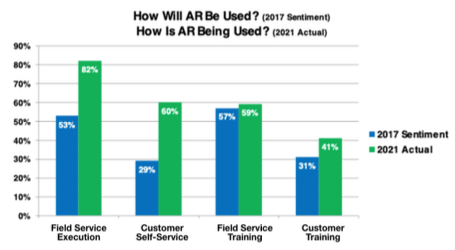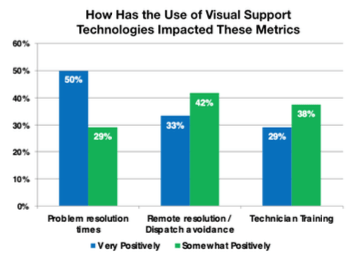Help Lightning Blog
AR-Enabled Technologies In Field Service: Preliminary State Of The Market Report

Written by Michael Israel, COO for the Service Council. Sponsored by Help Lightning.
This summary report provides preliminary highlights of the state of the market for AR adoption in Field Service. It also includes an analysis of how that has evolved since the original 2017 survey. And, finally, a suggestion about how that evolution is likely to continue over the next two years.
State Of The Market Preliminary Report: Executive Summary
Join our free webinar – date and time TBD. Get a full readout on the final state of the market report. All participants in the live will also receive a free copy of the report.
Augmented Reality (AR) technology was first developed by the US Air Force Research Laboratory in the early 1990’s. The concept was to overlay virtual visual information on a real-world workspace to help improve human performance in the execution of a task. Since that early development effort, AR has been adopted by multiple industries, including communications, education, entertainment, and medicine.1
For companies servicing equipment in these and other diverse industries, AR can deliver potentially significant improvements in service performance.
Service Council first surveyed its member community about Augmented Reality sentiment and adoption in 2017. In 2021, Service Council gathered updated information about AR in both the Voice of the Field Service Engineer (VoFSE) survey and the Technology Investment Plans survey. The Technology Investment Plans survey is currently open and accepting additional input.
This summary report provides preliminary highlights of:
- the state of the market for AR adoption in Field Service
- an analysis of how that has evolved since the original survey
- a suggestion about how that evolution is likely to continue over the next two years
1 Augmented Reality History Information from Wikipedia
Evolution Of AR Technologies
In the original survey, nearly seven in ten respondents said that increasing product complexity was a key factor driving the evaluation and implementation of AR technology. That trend has only increased. In the 2021 VoFSE survey, more than seven in ten of the nearly 850 survey respondents said that product complexity has increased. To underscore that, more than nine in ten said that greater knowledge is required to service those products than was required when they first became a Field Service Engineer (FSE).
Survey respondents in 2017 felt that AR would be most helpful in training FSEs. They also acknowledged that AR would help FSEs complete their work, but improved training was their top expectation. As the chart below reveals, sentiment and actual results for training are consistent. But help for FSEs in delivering service work far surpasses the earlier expectations. Actual deployments for customer self-service and customer training also exceed earlier expectations.

As if to underscore the data about Field Service Execution in the above chart, more than 80% of the FSEs responding to the VoFSE survey said they either see AR as a potentially valuable tool in their arsenal, or they want to learn more about it. A very small minority doubted its value.

When Service Council first inquired in 2017, 60% of survey participants said they were evaluating Augmented Reality solutions at that time. Interest in deploying AR has only grown since then. Today, nearly 80% of respondents to the Technology Investment Planning survey say they are either planning on a new deployment of AR, or are planning on extending the use of the AR solution they already have.
Near-Term Outlook
Those planning further AR deployments do so with good reason. Nearly 80% report that use of, for example, an augmented reality video call has either “very positively” or “somewhat positively” impacted problem resolution times. Three-fourths report a positive impact on helping customers resolve problems without having to dispatch an FSE. Dispatch avoidance is an increasingly important KPI amongst service leaders. Two-thirds think FSE training has benefited.

These results imply improvements over earlier 2017 data, where only 60% of the AR users were satisfied with the results they had gotten up to that point. While the earlier users felt they had seen improvements in first-time fix rates, remote problem resolution, and FSE training, they were not able to quantify those improvements.
Planning New Or Additional AR Deployments
Of those planning new or additional AR deployments, more than eight in ten plan to begin those deployments within two years. The majority of those will begin deployments within twelve months. Half of the companies planning on new or additional deployments report that budgets and spending plans for the deployments are approved. The other half say budgets are in the development and approval process. So, it’s possible some budgets will be denied or scaled back, curtailing some deployment plans.
Every company planning to deploy AR cites a top driver for such deployments:
“to assist field engineers with their service jobs”
Respondents cite improvements for FSE training and help with customers self-service as other top reasons. 90% of these companies will deploy technology like an augmented reality video call to the field via smart phones and/or tablets; half are considering headsets or smart glasses.
State Of The Market — Current Assessment
Data gathered from both actual AR users and those considering AR show considerable growth in the awareness of AR capabilities and of the benefits it can provide. A majority of those with actual experience using AR in field service reported positive results. Especially with regards to first-time fix rates, customer self-service, and technician training. Those planning on deploying AR are even more optimistic regarding the improvements they expect to see overall. Executives in industrial automation, IT services, food & beverage, and healthcare/medical industries are especially upbeat about positive developments for several important key measurements.
These include:
- problem resolution times
- first-time fix rates
- dispatch avoidance through remote problem resolution
- technician productivity
- training effectiveness
- plus, the impact on customer satisfaction and retention
They’re also looking forward to lower cost per service call and improved service margins.
Opportunities Still Exist To Improve Adoption
Actual and anticipated AR-provided benefits are encouraging. However, actual AR adoption in field service does not yet appear to be widespread. When asked what they relied on for help in resolving service problems, only a small percentage of FSE respondents to the VoFSE survey said they rely on AR for that assistance. The 2017 research showed a similarly small adoption rate. The apparent slow adoption may be due to a variety of factors.
Among these:
- cost of the software and/or the devices needed to take advantage of the software
- lack of faith that AR can actually deliver on its promise
- inadequate skills needed to successfully leverage AR capabilities
- experienced FSEs may worry the technology will undercut their value
- poor adoption in the field once deployed
Significant Benefits For Field Service Operations
Nonetheless, there’s little doubt that AR can provide significant benefits for field service operations. When a virtual assistant can successfully guide an FSE through a complex repair, that’s a huge benefit to the FSE, the service company, and most importantly, the end customer. And doing so while simultaneously training that FSE on the repair process so he/she can do it correctly and quickly next time. It may be an even greater benefit to all if AR can guide a customer through a repair process. This may avoid a technician visit altogether.
Properly implemented, something like an augmented reality video call can shorten training time for newly hired FSEs. It can help up-skill existing FSEs so they become more effective at diagnosing, repairing, and restoring equipment to peak performance. Moreover, AR can aid in training FSEs on equipment not previously known, creating the opportunity to service similar equipment, even competitors’ equipment, in adjacent markets. Such re-skilled technicians can then service an expanded pool of equipment. This can mitigate the challenges posed by labor and talent shortages. These newly skilled FSEs also open the door to additional revenue streams.
Service Council has consistently encouraged the creation of a “Technician Agnostic” service delivery infrastructure. That is, service delivery that is consistent, reliable, and thorough – no matter who is providing the service. Augmented Realty’s ability to aid in up-skilling, re-skilling, and cross-training FSEs can facilitate the development of a “Technician Agnostic” service.
Service Council suggests two key approaches to ensure a successful deployment:
Utilize Pilot Implementations
Service Council advocates a “think big, start small” approach. Roll the solution out to a subset of users first, if possible. Learn from the successes, failures, and pitfalls of the pilot and apply those lessons to the next phase. Having said that, AR has the potential to provide a significant competitive advantage to those companies that use it effectively. So, some sense of urgency may be appropriate to establish that advantage as early as possible.
Develop and follow strict change management plans and processes
Actively engage and seek feedback from the initial FSE users. Secure consistent executive support. Publicize successes – frequently; successes such as pilot go-live dates, stories about how AR helped resolve a difficult problem, training gains, etc. Finally, communicate constantly to all those affected: FSEs, dispatchers/call center staff, management, and most importantly – customers.
Join our free webinar – date and time TBD to get a full readout on the final state of the market report. All participants in the live will also receive a free copy of the report.
About the Author
Michael Israel is Service Council’s COO. Michael has worked in customer and field service for more than 40 years. He spent 17 years in his early career managing both domestic and international field service operations, including 12 years with IBM’s Field Engineering organization. Over the past three decades, he has held management and executive roles with major providers of CRM and Field Service software applications, including tenures with IFS, Oracle, and SAP.
His broad experience includes marketing, selling, supporting, and implementing CRM and Field Service software applications. Michael also served as a Field Service analyst for both Aberdeen Group and Technology Services Industry Association (TSIA).
About Help Lightning
Help Lightning’s Remote Visual Assistance software provides next generation video collaboration services that enable a company’s experts to work virtually side-by-side with anyone needing help, anywhere in the world. The company’s cloud-based solution applies augmented reality features. These include the merging of two video streams and the use of 3D annotation to improve real-time communications and solve difficult problems.
Help Lightning is used for the installation, inspection, training, servicing, and repair of complex equipment and products.
Using augmented reality features, Help Lightning blends two real-time video streams. This includes that of the agent and of the customer into a collaborative work environment. This innovative technology allows an agent to virtually reach out and touch what the customer is working on. The agent’s hand displays in the customer’s field of view where they can annotate, and use hand gestures. They can even bring in tools, parts, images or instructions to quickly resolve the problem. Also, captured pictures, session recordings, and call data all become part of the call record for later review or training purposes.
Through an augmented reality video call, Help Lightning provides real-time video collaboration. This enables company experts to work virtually side-by-side with anyone needing help, anywhere in the world. Ideal for complex equipment maintenance, repair, and training.
Ready to learn more?
Request a demo of an augmented reality video call.












